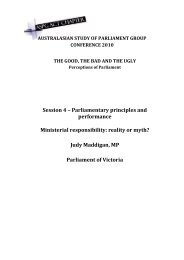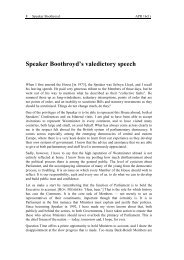Comic Commentators: Contemporary Political Cartooning in Australia
Comic Commentators: Contemporary Political Cartooning in Australia
Comic Commentators: Contemporary Political Cartooning in Australia
- No tags were found...
You also want an ePaper? Increase the reach of your titles
YUMPU automatically turns print PDFs into web optimized ePapers that Google loves.
Spr<strong>in</strong>g 2009 Book pages 233Mohammed and on Indonesian President SBY when there was cartoon potential tomake a political po<strong>in</strong>t. Delonas and Leak are throw<strong>in</strong>g down the gauntlet, test<strong>in</strong>gthe boundaries of freedoms and perhaps boast<strong>in</strong>g of them, and dar<strong>in</strong>g their editorsto censor or their subjects to sue.In their exam<strong>in</strong>ation of ‘Cartoonists and the Law’, Handsley and Phiddian expla<strong>in</strong>why they don’t. They conclude that the K<strong>in</strong>g and the pear pr<strong>in</strong>ciple still prevails;there is very little defamation action aga<strong>in</strong>st cartoonists (even though it wascartoon<strong>in</strong>g that led to the development of the law of crim<strong>in</strong>al libel <strong>in</strong> the UK <strong>in</strong> theeighteenth century). 18 In 1832 France, cartoonist Charles Philipon was imprisonedfor a caricature of K<strong>in</strong>g Louise Philippe as a pear. The issues was the divisionbetween satire and subversion. In its pursuit, far greater publicity for the offend<strong>in</strong>gimage followed than would otherwise have been the case. Moir concludes that afterthis experience, it became the convention <strong>in</strong> France, and <strong>in</strong> most of Europe, totolerate satirical cartoons, and this convention became a major foundation <strong>in</strong> thebuild<strong>in</strong>g of the free press <strong>in</strong> the West (p. 58–9).K<strong>in</strong>gs, potentates and (most) politicians quickly learnt that compla<strong>in</strong>t aboutcartoons only exaggerates and prolongs the lampoon<strong>in</strong>g and casts its subject <strong>in</strong> evenworse light. Thus cartoonists came to enjoy de facto exemption from suit on theback of a l<strong>in</strong>k which reaches to the guarantee of freedom of speech <strong>in</strong> theConstitution. Handsley and Phiddian conclude that the sedition laws of November2005 are unlikely to change this state of affairs except to trigger more selfcensorship,though this may be significant <strong>in</strong> itself if cartoons are pulled by legaldepartments fearful of legal reprisal.The lesson of the K<strong>in</strong>g and the pear seems lost on some who protest the portrayal offemale politicians today. Haydon Mann<strong>in</strong>g courageously tackles this difficultsubject <strong>in</strong> his chapter on ‘<strong>Australia</strong>n Cartoonists’ Caricatures of WomenPoliticians’, argu<strong>in</strong>g the pros and cons of the case and conclud<strong>in</strong>g that ‘…draw<strong>in</strong>gblood is a licence cartoonist must enjoy if their art is to have <strong>in</strong>tegrity andpurpose…’ (p. 128). We are left wonder<strong>in</strong>g whether the essence of the fem<strong>in</strong>istargument, <strong>in</strong>clud<strong>in</strong>g concepts of ‘fair’ and unfair’, are <strong>in</strong> fact a plea for specialtreatment, for which read censorship?Influence?: ‘Try<strong>in</strong>g to catch the w<strong>in</strong>d…’ Margeurite MahoodAs Margeurite Mahood so delightfully put it the conclusions of her study of‘<strong>Australia</strong>n <strong>Political</strong> Caricature 1788-1901’: ‘to ask, as is often done, “To whatextent does the political cartoon <strong>in</strong>fluence public op<strong>in</strong>ion” is like try<strong>in</strong>g to catch thew<strong>in</strong>d’. If this is the case, then the question of their <strong>in</strong>fluence should rest <strong>in</strong> the18 Accord<strong>in</strong>g to the Hon B S J O’Keefe, AM QC, President of the National Trust of<strong>Australia</strong> (NSW) <strong>in</strong> his foreword to ‘Artists and Cartoonists <strong>in</strong> Black and White: The mostpublic art’, by Joan Kerr, SH Erv<strong>in</strong> Gallery, Sydney 1999.
















